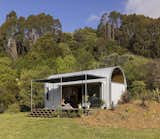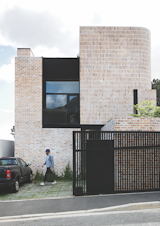The home is clad in corrugated iron coated with Zincalume. “We chose the cladding so we could curve the metal sheets and create barrel vaulted roofs,” says architect William Samuels. “The finish gives a natural reflection to the surface of the house, picking up on the colors of the surrounding bush and the changing daylight.”
The Cape Town house that architect Michael Lumby designed for his friends Robyn and Clint Campbell is clad in simple, inexpensive brick in varying patterns that allow its facade to curve. The facade has a similarly rough finish. “I wanted something that will age and patina with time and be low maintenance,” says Lumby.
Boyer first visited the site in 2018 for the redesign. Having grown up in the area, it was awful to see the devastating effects of the fire, but there were also signs of regrowth just a year later. “The redwoods had started to grow a little fuzzy green against the charred black [bark],” says Boyer. “It was kind-of promising. It felt hopeful that nature was coming back so quickly.”
Steve and Margaret Cegelski, a retired couple who invented a popular tire sealant, welcome guests to their Santa Barbara County home nearly every weekend for hiking, surfing, and horseback riding. Overnight visitors stay in the new guesthouse designed by Dan Weber of Anacapa Architecture and Steve Willson of Willson Design; the builder was Curtis Homes, and the structural engineer was Ashley & Vance Engineering. A green roof helps the structure disappear into the site high above the Pacific. “We wanted to capture the quality of the setting, but with minimal impact on the land,” says Weber.
On an undulating stretch of California coastline, a hidden guesthouse runs free of the grid. "The house is elemental," says project architect Dan Weber of Santa Barbara–based firm Anacapa, who collaborated on the project with designer Steve Willson. "We endeavored to make it out of materials that would wear and take on a patina over time, so they could feel like part of the landscape." Unfinished steel, board-formed concrete, and glass continue inside, where rich black walnut—used for ceilings, cabinetry, and furniture—provides an inviting contrast. "On a foggy day, you want that feeling of warmth around you," says Margaret. Brass fixtures complement the deep-hued wood.
Buenos Aires–based architect and furniture designer Alejandro Sticotti combined clean lines and a handmade aesthetic at his beach house in Uruguay. The home is made up of two stacked boxes built from steel and board-formed concrete and wrapped in glass and tropical hardwood. Surrounded by a fence in the coastal town of La Pedrera, it is a sanctuary within a sanctuary.





![Boyer first visited the site in 2018 for the redesign. Having grown up in the area, it was awful to see the devastating effects of the fire, but there were also signs of regrowth just a year later. “The redwoods had started to grow a little fuzzy green against the charred black [bark],” says Boyer. “It was kind-of promising. It felt hopeful that nature was coming back so quickly.”](https://images2.dwell.com/photos/6272473203005894656/6838340655016390656/original.jpg?auto=format&q=35&w=160)







